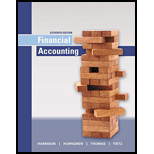
Financial Accounting Plus MyLab Accounting with Pearson eText - Access Card Package (11th Edition)
11th Edition
ISBN: 9780134436135
Author: Walter T. Harrison Jr., Charles T. Horngren, C. William Thomas, Wendy M. Tietz
Publisher: PEARSON
expand_more
expand_more
format_list_bulleted
Question
Chapter 1, Problem 1.8S
1.
To determine
To measure: Liabilities when assets and equity of the business are known.
2.
To determine
To measure: Owners’ equity of household when liabilities and assets of the business are known.
Expert Solution & Answer
Want to see the full answer?
Check out a sample textbook solution
Students have asked these similar questions
I am looking for help with this general accounting question using proper accounting standards.
I am searching for the accurate solution to this general accounting problem with the right approach.
I need guidance with this general accounting problem using the right accounting principles.
Chapter 1 Solutions
Financial Accounting Plus MyLab Accounting with Pearson eText - Access Card Package (11th Edition)
Ch. 1 - Prob. 1QCCh. 1 - Prob. 2QCCh. 1 - Prob. 4QCCh. 1 - Prob. 5QCCh. 1 - Prob. 6QCCh. 1 - Prob. 7QCCh. 1 - Prob. 8QCCh. 1 - Prob. 9QCCh. 1 - Prob. 10QCCh. 1 - Prob. 11QC
Ch. 1 - Prob. 12QCCh. 1 - Prob. 13QCCh. 1 - Prob. 14QCCh. 1 - Prob. 1.1ECCh. 1 - Prob. 1.1SCh. 1 - Prob. 1.2SCh. 1 - LO 4 (Learning Objective 4: Identify income...Ch. 1 - Prob. 1.4SCh. 1 - (Learning Objective 2: Explain underlying...Ch. 1 - Prob. 1.6SCh. 1 - Prob. 1.7SCh. 1 - Prob. 1.8SCh. 1 - Prob. 1.9SCh. 1 - LO 4 (Learning Objective 4: Explain aspects of...Ch. 1 - Prob. 1.11SCh. 1 - Prob. 1.12SCh. 1 - Prob. 1.13SCh. 1 - Prob. 1.14SCh. 1 - Prob. 1.15SCh. 1 - Prob. 1.16SCh. 1 - Prob. 1.17SCh. 1 - Prob. 1.18SCh. 1 - Prob. 1.19AECh. 1 - Prob. 1.20AECh. 1 - Prob. 1.21AECh. 1 - Prob. 1.22AECh. 1 - Prob. 1.23AECh. 1 - Prob. 1.24AECh. 1 - Prob. 1.25AECh. 1 - Prob. 1.26AECh. 1 - Prob. 1.27AECh. 1 - Prob. 1.28AECh. 1 - Prob. 1.29AECh. 1 - Prob. 1.30AECh. 1 - Prob. 1.31BECh. 1 - Prob. 1.32BECh. 1 - Prob. 1.33BECh. 1 - Prob. 1.34BECh. 1 - Prob. 1.35BECh. 1 - Prob. 1.36BECh. 1 - Prob. 1.37BECh. 1 - Prob. 1.38BECh. 1 - Prob. 1.39BECh. 1 - Prob. 1.40BECh. 1 - Prob. 1.41BECh. 1 - Prob. 1.42BECh. 1 - Prob. 1.43QCh. 1 - Prob. 1.44QCh. 1 - Prob. 1.45QCh. 1 - Prob. 1.46QCh. 1 - Prob. 1.47QCh. 1 - Prob. 1.48QCh. 1 - Prob. 1.49QCh. 1 - Prob. 1.50QCh. 1 - Prob. 1.51QCh. 1 - Prob. 1.52QCh. 1 - Prob. 1.53QCh. 1 - Prob. 1.54QCh. 1 - Prob. 1.55QCh. 1 - Prob. 1.56QCh. 1 - Prob. 1.57QCh. 1 - Prob. 1.58APCh. 1 - Prob. 1.59APCh. 1 - Prob. 1.60APCh. 1 - Prob. 1.61APCh. 1 - Prob. 1.62APCh. 1 - Prob. 1.63APCh. 1 - Prob. 1.64BPCh. 1 - Prob. 1.65BPCh. 1 - Prob. 1.66BPCh. 1 - Prob. 1.67BPCh. 1 - Prob. 1.68BPCh. 1 - Prob. 1.69BPCh. 1 - Decision Cases LO 1, 4 (Learning Objectives 1, 4:...Ch. 1 - Prob. 2DCCh. 1 - Prob. 1EI
Knowledge Booster
Similar questions
- When should strategic performance linkage guide measurement? (1) Strategy remains separate (2) Long-term objectives require aligned metrics development (3) Short-term measures suffice (4) Standard metrics work fine helparrow_forwardV Industries has sales of $240,000 and the cost of goods available for sale of $198,000. If the gross profit rate is 32.75%, the estimated cost of the ending inventory under the gross profit method is? Accurate answerarrow_forwardSolve this Accounting MCQ 63arrow_forward
- During November, Pico Company had $120,300 of cash receipts and $119,750 of cash disbursements.arrow_forwardI am searching for the correct answer to this general accounting problem with proper accounting rules.arrow_forwardI need help finding the accurate solution to this general accounting problem with valid methods.arrow_forward
arrow_back_ios
SEE MORE QUESTIONS
arrow_forward_ios
Recommended textbooks for you

 AccountingAccountingISBN:9781337272094Author:WARREN, Carl S., Reeve, James M., Duchac, Jonathan E.Publisher:Cengage Learning,
AccountingAccountingISBN:9781337272094Author:WARREN, Carl S., Reeve, James M., Duchac, Jonathan E.Publisher:Cengage Learning, Accounting Information SystemsAccountingISBN:9781337619202Author:Hall, James A.Publisher:Cengage Learning,
Accounting Information SystemsAccountingISBN:9781337619202Author:Hall, James A.Publisher:Cengage Learning, Horngren's Cost Accounting: A Managerial Emphasis...AccountingISBN:9780134475585Author:Srikant M. Datar, Madhav V. RajanPublisher:PEARSON
Horngren's Cost Accounting: A Managerial Emphasis...AccountingISBN:9780134475585Author:Srikant M. Datar, Madhav V. RajanPublisher:PEARSON Intermediate AccountingAccountingISBN:9781259722660Author:J. David Spiceland, Mark W. Nelson, Wayne M ThomasPublisher:McGraw-Hill Education
Intermediate AccountingAccountingISBN:9781259722660Author:J. David Spiceland, Mark W. Nelson, Wayne M ThomasPublisher:McGraw-Hill Education Financial and Managerial AccountingAccountingISBN:9781259726705Author:John J Wild, Ken W. Shaw, Barbara Chiappetta Fundamental Accounting PrinciplesPublisher:McGraw-Hill Education
Financial and Managerial AccountingAccountingISBN:9781259726705Author:John J Wild, Ken W. Shaw, Barbara Chiappetta Fundamental Accounting PrinciplesPublisher:McGraw-Hill Education


Accounting
Accounting
ISBN:9781337272094
Author:WARREN, Carl S., Reeve, James M., Duchac, Jonathan E.
Publisher:Cengage Learning,

Accounting Information Systems
Accounting
ISBN:9781337619202
Author:Hall, James A.
Publisher:Cengage Learning,

Horngren's Cost Accounting: A Managerial Emphasis...
Accounting
ISBN:9780134475585
Author:Srikant M. Datar, Madhav V. Rajan
Publisher:PEARSON

Intermediate Accounting
Accounting
ISBN:9781259722660
Author:J. David Spiceland, Mark W. Nelson, Wayne M Thomas
Publisher:McGraw-Hill Education

Financial and Managerial Accounting
Accounting
ISBN:9781259726705
Author:John J Wild, Ken W. Shaw, Barbara Chiappetta Fundamental Accounting Principles
Publisher:McGraw-Hill Education